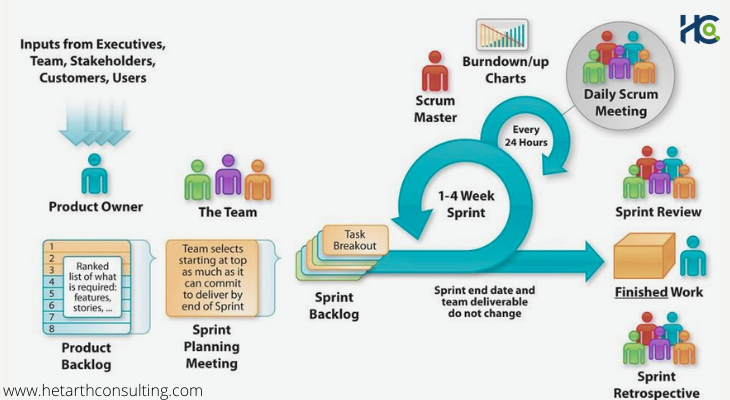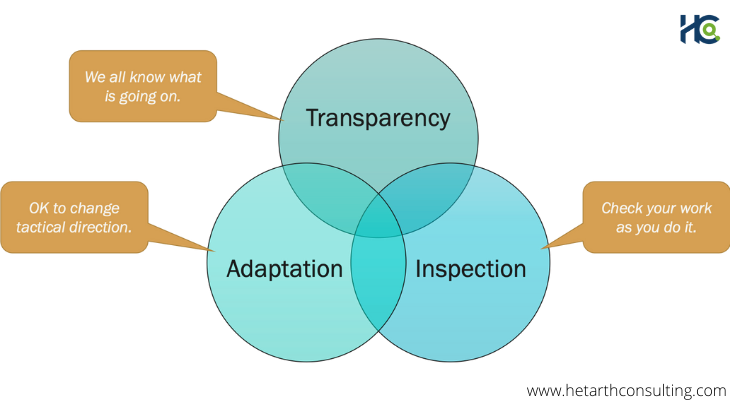Scrum – What It Is, How It Works, and Why It’s Awesome
December 16, 2021
Last Updated: December 16, 2021
What is Agile?
It is a philosophy that uses an organizational model on People, Collaboration & Values. When applied, it produces an Empirical Process.
Being agile means people collaborating together to build high quality products that meet customer needs at a sustainable pace.
Agile is a base philosophy for a wide spectrum of different software development methodologies, including Scrum, Kanban, Lean, and XP.
Agile Manifesto
- Individuals and Interactions over Processes and Tools
- Working Software over Comprehensive Documentation
- Customer Collaboration over Contract Negotiation
- Responding to Change over Following Plan
What is Scrum?
Scrum, arguably the most popular Agile framework in use across industries, has been proven to help develop products in a timely and highly efficient manner. The 14th State of Agile Report states that 97% of organizations practice Agile development, out of which 58% prefer to use Scrum as their go-to method.
Scrum lays out a series of simple principles and processes, which are very easy to follow and get measurable results. According to it, the project development is handled in short iterations to allow for business and engineering flexibility. The main idea behind Scrum and, ultimately, Agile is to continuously deliver value to customers.
It’s reflected both in terms of how a given project is managed and what kind of mindset the team members have. If you look closer, Scrum is mostly used for long-term complex projects that require business and engineering flexibility.

What is Sprint?
A timebox or a fixed span of time is called Sprint in Scrum. Maximum length of the Sprint recommended by the Scrum framework is Four Weeks.
A Sprint has:
- Fixed Goal
- Fixed Team
- Fixed Length
- Product Increment at the end
Why Timeboxing?
Expedites Pivoting:
- By eliminating procrastination
- By providing frequent opportunities to get customer feedback.
Enables Continuous Improvement:
- By measuring and learning to deliver at a sustainable pace.
- By inspecting and adapting products and systems.
Scrum Team and Roles
A timebox or a fixed span of time is called Sprint in Scrum. Maximum length of the Sprint recommended by the Scrum framework is Four Weeks.
Scrum Master
This person makes sure that the team aligns its actions with Scrum principles, helps reconcile members, and resolve conflicts. Sometimes, a Scrum master contributes to the end sprint goals.
- Systems Coach. Identify and Address Systemic Issues.
- Transformation Coach. Create awareness about prevailing Mental Models to enable Teams/Organizations Transform.
- Facilitator. Create visibility to the Big Picture.
- Relationship Coach. Identify and Address the Dysfunctions in the Scrum Team.
Product Owner
This person takes the responsibilities of the product manager. He or she represents the end customer and other stakeholders communicating the overall vision of the product.
- User Research. Understand user problems. Translate user problems into needs. Understand alternate solutions available to users. Translate the user needs to product features.
- Product Development. Create a product backlog. Collaborate with the team to refine Product Backlog. Review the work done by the team and provide feedback. Guide them in building the right product.
- Business Model Design. Design Business model. Create Product roadmap. Design product pricing. Manage product scope and budget.
- Market Research. Analyze competitors. Identify market segment. Position the product in the market. Design Product Promotion strategy.
Development Team
The team must be cross-functional, self-organizing, and well… agile. For these reasons, the number of team members mustn’t exceed seven people.
- Autonomous. To make their own decisions. Identify and implement suitable processes. To identify and use development practices. Self-Organized.
- Cross-Functional. Has the ability to deliver end to end functionality (Program, Test, Package, integrate, Technical Writing, etc.). No dependency on other teams to create a product increment. Personal Mastery.
- Small Team. Small enough to reduce handoffs. Self-organize and collectively own deliverables. Work towards improving collective capability rather than individuals. Team Learning.
Scrum Artifacts
Artifacts are development documents created by the team during development and there are three main ones.
Product Backlog
Anything and everything required to fulfill the Product Vision. The main backlog contains various requirements documented as user stories or other formats. The document is the main source of requirements and is constantly updated with new items.
It may contains:
- Functional requirements
- Non-functional requirements
- Change requests
- Enhancements
- Defects
- POCs/Spikes
It may expressed as:
- User Story
- Use Case
- Flowchart
- Voice of Customer, etc.
Sprint Backlog
A plan which helps the Development Team self-organize to achieve the Sprint Goal. The sprint backlog contains requirement items that the team committed to complete during a given sprint. As you’ve guessed, sprint backlog items are sourced from the product backlog.
It may contains:
- Planned PBIs: The PBIs that the team plans to deliver to achieve Sprint Goal.
- Tech Tasks: Tasks required to accomplish planned PBIs.
Product Increment
An integrated increment of the final product built iteratively.
It may contains:
- Software Package
- Release notes
- User manual
- Support documents, etc.
Scrum Meetings
Recognizing that the team knows better how to solve the arising problems, Scrum methodology doesn’t impose many rules. So, the logic and goals of Scrum meetings align with the desired outcome rather than the methodology guidelines. There is, however, a traditional set of meetings.
Sprint Planning
A planning meeting at the beginning of each sprint is held to decide how many user story (or other requirement) items the team commits to.
- Purpose: For the Scrum Team to craft a Sprint Goal and create a plan to achieve it.
- Participants: The Scrum Team
- Input: Product Backlog, Past Performance (Velocity), Product Increment
- Output: Sprint Goal, Sprint Backlog, Sprint Burndown / Sprint Burnup
Activities for Sprint Planning:
- Craft a Goal: Where do we stand with respect to the Sprint Goal?
- Create a Plan: Are there any impediments to making progress?
- Define KPIs: How will you measure the progress towards Sprint Goal? What measures will help you know that you have achieved a Sprint Goal?
Daily Scrum
Every day all team members participate in a daily Scrum meeting. The goal of a sprint daily meeting is to discuss what was done yesterday and what’s planned to be done today. Daily scrums synchronize the work of the team and maintain the work pace.
- Purpose: A formal opportunity to inspect the team’s progress with respect to Sprint Goal and adapt the plan to get there.
- Participants: Development Team, Scrum Master, Product Owner (although optional, it’s highly advisable to include them).
- Input: Sprint Backlog, Sprint Burndown / Sprint Burnup, etc.
- Output: Action items to resolve impediments
Activities for Daily Scrum:
- Inspect: Where do we stand with respect to the Sprint Goal?
- Identify: Are there any impediments to making progress?
- Adapt: What should we do to achieve the Sprint Goal?
Product Backlog Refinement
A product backlog refinement meeting is held one or two times a week to remove the items that are no longer needed in the backlog, add new items if necessary, add or remove some of the acceptance criteria, prioritize, and specify estimates.
- Purpose: For the Scrum Team to refine and keep the Product Backlog ready for future Sprints.
- Participants: The Scrum Team, Other SMEs, Representative from downstream or upstream products.
- Input: Product Backlog, Product vision, Comments from Sprint Review
- Output: Refined Product Backlog (Ready for at least two Sprints)
Activities for Product Backlog Refinement:
- Understand: PO explains PBIs to the Team and the Team asks questions.
- Refine: Scrum team adds details such as: workflows, dependencies, business rules, infrastructure needs, data and creates wireframes, prototypes, etc.
- Estimate and Split: development team estimates PBIs & splits them until they are small enough for a Sprint.
Sprint Review
The meeting happens at the end of each sprint. The team shows what they’ve produced during the past sprint to stakeholders.
- Purpose: A formal opportunity to review the work done. To test assumptions, fail faster and learn about user needs. Helps reduce the risk of building an unused product and cost of delay (Sunk cost, opportunity cost, etc.).
- Participants: The Scrum Team, Sponsors, Customers, End Users, Field Engineers, Sales Folks, Anyone who can provide feedback.
- Input: Product Increment, Sprint Goal, Release Burndown of the current release
- Output: Updated Product Backlog
Activities for Sprint Review:
- Set the Stage: Product Owner explains the Sprint Goal, what is done and not done.
- Demo: Development Team demos Product Increment and Stakeholders provide feedback.
- Forecast: Product Owner discusses the Product Backlog as it stands today and projected completion date.
Sprint Retrospective
And this last type is also set at the end of the sprint. The retrospective goal is to discuss what went wrong and what went well during the sprint to better align the project progression with goals.
- Purpose: A formal opportunity to review the system (processes, structures, policies, etc.). Identify areas for improvement in upcoming Sprints to build a sustainable system that reduces production cost.
- Participants: The Scrum Team
- Input: Sprint Burndown / Sprint Burnup, Impediment list, Comments from Sprint Review, Observation from Scrum Team
- Output: Action items for next sprint
Action Items for Sprint Retrospective:
- Reflect Back: Scrum Team discusses how the current Sprint goes and learning from it. Discuss issues faced during the Sprint, identify root causes and discuss action items to address them.
- Look Forward: Understand current capability of the team, look forward to the goals to be achieved and identify action items to improve the system to achieve the goals.
Scrum Values
- Focus. As we focus only on a few things at a time, we work well together and produce excellent work, we deliver value sooner.
- Openness. Transparency of our results, problems, strengths, development needs helps us create a culture of openness.
- Respect. As we work together, sharing success and failure, we respect each other, our agreements and commitments.
- Commitment. As we have greater control over what we do and how we do, we become more committed to success.
- Courage. As we work together and feel supported, we are courageous to be open and challenge ourselves to go beyond our capabilities.
Definition of Done
An exit criteria agreed by Product Owner and Development Team to consider a PBI done and ready to be shipped.
For Example:
- Coded
- Reviewed
- Bug Fixed
- Packaged
- Test cases automated
- Test cases written
- Tested
- Integrated
- Deployed
- Accepted by Product Owner, etc.
Empirical Process in Scrum
Empiricism means working in a fact-based, experience-based, and evidence-based manner. Scrum implements an empirical process where progress is based on observations of reality, not fictitious plans. Scrum also places great emphasis on mind-set and cultural shift to achieve business and organizational Agility.
Any process that exhibits transparency, so that the team can inspect their progress with respect to the goal and adapt their plan, process, design, etc. to achieve the goal, is called Empirical Process.
The three pillars of empiricism are as follows:

Transparency
This means presenting the facts as is. All people involved—the customer, the CEO, individual contributors—are transparent in their day-to-day dealings with others. This promotes an easy and transparent flow of information throughout the organization and creates an open work culture.
In Scrum, Transparency is depicted through:
- Artifacts. Project Vision Statement, Prioritized Product Backlog, Release Planning Schedule
- Meetings. Sprint Review Meetings, Daily Standup Meetings
- Information Radiators. Burndown Chart, Scrum Board
Inspection
Inspection in this context is not an inspection by an inspector or an auditor but an inspection by every- one on the Scrum Team. The inspection can be done for the product, processes, people aspects, practices, and continuous improvements.
In Scrum, Inspection is depicted through:
- Use of a common Scrum Board and other information radiators.
- Collection of feedback from the customer and other stakeholders during the Develop Epic(s), Create Prioritised Product Backlog , and Conduct Release Planning processes.
- Inspection and approval of the Deliverable by the Product Owner and the customer in the Demonstrate and Validate Sprint Process.
Adaptation
Adaptation in this context is about continuous improvement, the ability to adapt based on the results of the inspection. Everyone in the organization must ask this question regularly: Are we better off than yesterday?
In Scrum, Adaptation is depicted through:
- Standup Meetings
- Constant Risk Identification
- Change Requests
- Scrum Guidance Body
- Retrospect Sprint Meeting
- Retrospect Project Meeting
In the End…
For those who look-out for an effective certified scum master, Hetarth Consulting will undoubtedly be your guide to coaching you to the zenith of success. You can hire a scrum master from our expert team to guide yourself for the future to serve as a facilitator for the product owner and the development teams. Embark on the journey of Agile and Lean thinking with our team.
Good Luck!!
Wondering how to build
an exclusive software product for your business?
Discuss your project needs with our architects.








